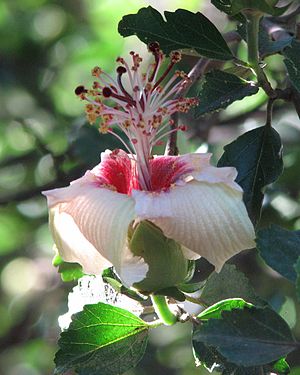Hibiscus insularis
| Hibiscus insularis | ||||||||||||
|---|---|---|---|---|---|---|---|---|---|---|---|---|

Hibiscus insularis |
||||||||||||
| Systematics | ||||||||||||
|
||||||||||||
| Scientific name | ||||||||||||
| Hibiscus insularis | ||||||||||||
| Final |
Hibiscus insularis is a rare species of the mallow family. It is endemic to Phillip Island .
features
Hibiscus insularis is a densely branched shrub that reaches a height of 1 to 2.5 meters. The crown is rounded. The egg-shaped, notched leaves are 4 to 6 inches long. The flowers are solitary in the leaf axils. They reach a diameter of 8 centimeters. Each flower has three to six egg-shaped 10 to 13 millimeter long bracts, a five-lobed, bell-shaped, felt-like calyx about 22 millimeters long and five elongated, light lemon-yellow partially curved petals about 6 centimeters long. The veins of the petals are pink and the entire flower becomes pink with age. The fruit consists of five chambers, which are surrounded by a permanent calyx.
ecology
The seedlings of Hibiscus insularis have very small leaves that are formed in a deeply lobed juvenile shape. This stage can be maintained for up to 20 years before the adult form of the leaves is produced. Since so far only leaves in the adult form have been discovered, a long generation time for Hibiscus insularis can be assumed. The flowers of Hibiscus insularis grow upward from the ends of the branches with rarely more than one flower at the same stage on the same branch. Large amounts of nectar are produced. When the flowers open for the first time they are female, a day later they have reached the male stage. Over the next few days, the flowers turn pink and close when they wilt. Hibiscus insularis is thought to be pollinated by birds, however it is possible that the original pollinators may have become extinct. Hibiscus insularis is capable of producing seeds through self-pollination. Vegetative propagation by stem cuttings is also possible.
Existence and endangerment
In the past, overgrazing and soil degradation by feral pigs, goats and rabbits posed a major threat. As a result of renaturation and conservation projects, the introduced animals were removed from Phillip Island. Today neophytes such as the olive tree Olea europaea subsp. africana from. The African olive tree competes with Hibiscus insularis for water and nutrients. It forms dense thickets that block the expansion of Hibiscus insularis . Moth caterpillars , especially the species Pectinophora scutigera and Anisoplaca cosmia , reduce the ability of this species of hibiscus to produce viable seeds. Soil erosion on Phillip Island is also making it difficult for native vegetation to recover. In 1939 only 13 individuals were counted. In 1963 the population consisted of eight plants. In 1988 the species was detected in two small places, each with an area of 500 m². In 2001 a third location was added with an area of 500 m². In 2003 the number of adult plants occurring in the wild was less than 50. In cultivation, the species grows in the Norfolk Island Botanic Gardens, in the Booderee Botanic Gardens in Booderee National Park and in the Royal Botanic Gardens Melbourne.
literature
- Gren Lucas, Hugh Synge, International Union for Conservation of Nature and Natural Resources. Threatened Plants Committee: The IUCN plant red data book: comprising red data sheets on 250 selected plants threatened on a world scale . IUCN, 1978. ISBN 9782880322021